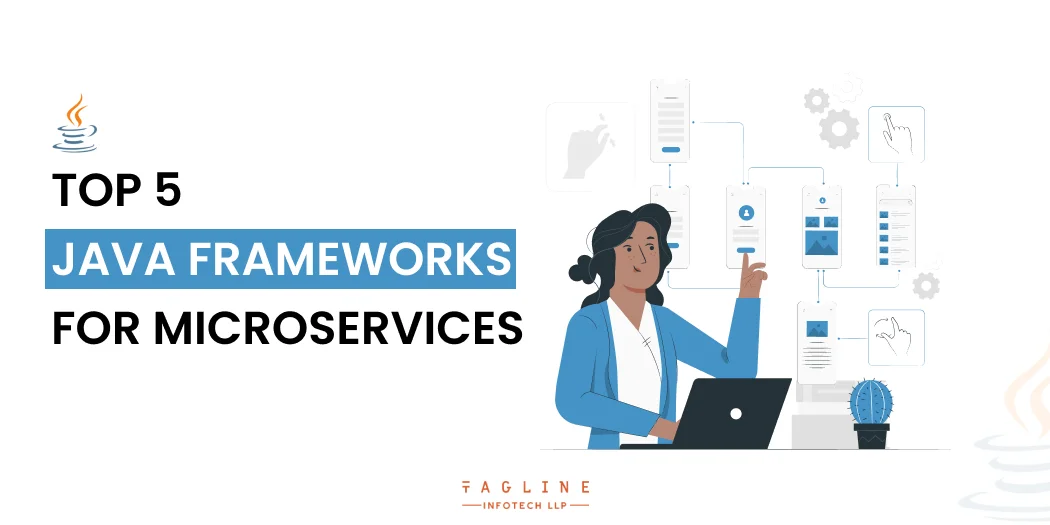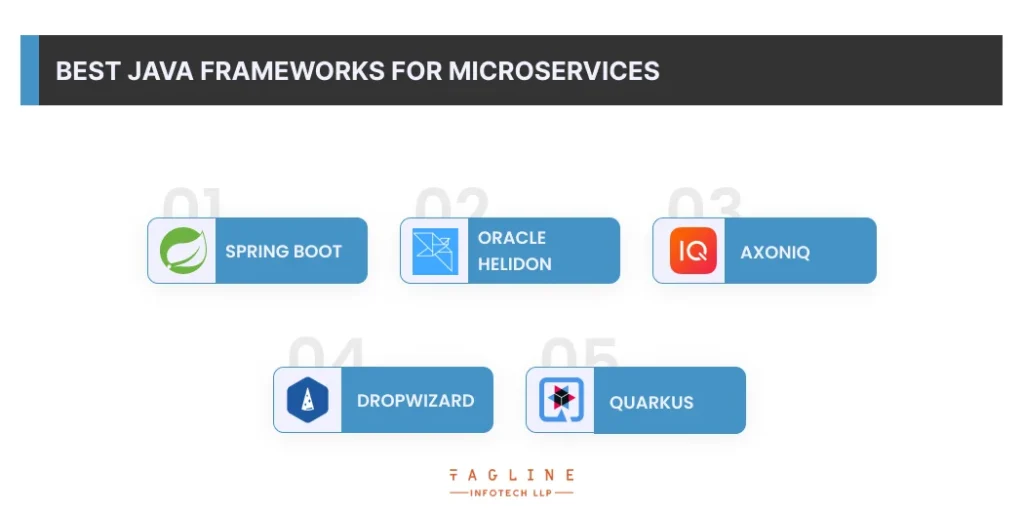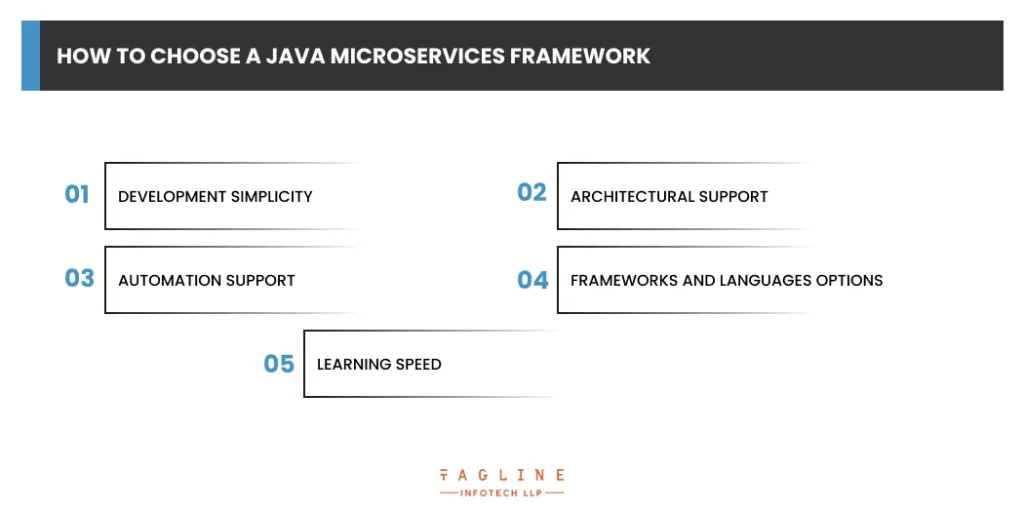Role of Python Libraries in Image Processing
October 30, 2025
Home >> Java >> Top 5 Java Frameworks For Microservices

Microservices are frequently used to build complicated systems with several functionalities by layering each component into a single unit. The idea that microservices are a method for building a single app out of a collection of tiny services where each service operates independently (in its process) may not be known to many of us.
In other words, Java frameworks for microservices are more of a service-oriented design that allows any software to be assembled in little pieces instead of producing a complete single entity. Even now, many companies and developers adore working beneath this bridge, particularly with Java microservice frameworks, since it gives them the freedom to be independent. This is because “Dependency on the same programming language literally ends” at this point, which is the main cause. It’s obvious that doing this improves efficiency and helps the boat control costs.

Let’s begin with the Top 5 Java Microservices Frameworks list.
One of the best and most user-friendly Java frameworks for creating microservices. It is open-source and packed with several capabilities and functionality that we haven’t yet possibly seen. In addition, it can be installed almost on any platform (like Docker) with ease. You may be confident that it provides a solid backstop of a sizable developer community network and that each inquiry will be answered. It also makes it possible to offer several unique built-in features, such as security, auto-configuration, starting dependencies (which speed up app development), and several other services.
Ready to level up your Java skills?
Investigate the capabilities of Java Frameworks and take use of its best features. We have a team of experts which you can help you achieve your business goals.
Two versions of Oracle Helidon, MP and SE, a collection of microservices framework Java-based , were made public. They are already regarded as viable options for many projects, even though both lack documentation due to their novelty.
Due to its foundation in the MicroProfile specification, Helidon MP is best suited for Java EE developers. As a toolkit containing the most recent Java SE features, Helidon SE includes reactive streams, native images for GraalVM, and functional and asynchronous programming.
Axon offers a single, effective technique for creating Java programmes that may change without requiring extensive modification.
Axon comprises both a software system and a specific architecture to provide business-ready support for the software system, particularly for the corporate software development process. Model and architecture are provided by Axon Framework and Axon Server, respectively. Each one is cost-free.
Another strong framework for creating RESTful microservices is DropWizard. It uses well-known Java technologies like Jetty, Jackson, and Jersey to speed up the development of high-performance Software programs.
It was developed to help developers build contemporary, highly functioning Java applications that would meet the demands of a cloud-native environment. In addition, it is a full-stack
Kubernetes-native platform designed for JVMs (Java Virtual Machines) specifically for containers, allowing them to survive in a serverless or purposeful cloud context. Eclipse, Kafka, Spring, and other Java frameworks were used in its creation. It provides GraaIVM (a high-performance JDK distribution) with the appropriate contextual data to allow support for the native compilation of Java applications.
“Top Java Frameworks for Web Development in 2023”
– Also Read Article

It is not surprising that with microservices, you may use a variety of technologies and programming languages while also creating a solid platform for corporate expansion.
The Java framework for microservices architecture is an impractical choice for those trying to keep their spending in check because of the running costs involved. Standardizing the tech stack by determining the optimum programming language for your company’s needs would be preferable.
Here are some important factors that should be taken into account while selecting the right framework are as follows:
Frameworks simplify the process of creating apps, increasing developer productivity and improving project results. The framework-supporting tools and IDEs are also essential for quickly creating apps.
The code modules and interfaces provided by frameworks used in microservices architecture have built-in design patterns. As a result, coding complexity is eliminated for application developers, simplifying and relaxing the process considerably.
Framework support is useful for automating processes linked to deploying and implementing the microservices, so developers may gain from it.
Different frameworks, including Spring Boot, Go Micro, AxonIQ, and Helidon, are available to construct microservices depending on the project’s requirements. Microservices are frequently developed in popular languages like Python, C++, Node.js, and Java.
A new framework’s official documentation, recommended practices, tutorials, and common problems must be read to become familiar with it. Solutions that are relatively new or unpopular would take much longer to learn since they frequently lack the previously listed components. This has an impact on team productivity and development time.
To create microservices, Java offers a broad range of effective frameworks, each with a unique set of capabilities and benefits. Spring Boot, Oracle Helidon, AxonIQ, DropWizard, and Quarkus are the top 5 Java frameworks for microservices. These frameworks provide a range of language choices, architectural support, automation capabilities, and ease of use in terms of development. It’s important to consider variables like ease of development, support for automation, support for architecture, available alternatives, and learning speed while choosing the best framework.
Due to its comprehensive frameworks, large developer community, and robust ecosystem, Java is a popular choice for creating microservices. To satisfy the needs of contemporary applications and cloud-native settings you need to hire Java developers who can effectively create scalable, modular, and maintainable microservices architectures using these frameworks. The final decision on which microservices framework to choose will be based on the particular needs and objectives of the project, as each framework has its advantages.
Basics, Examples, Frameworks, Interview: Java Microservices...
Microservices are a collection of loosely linked, tiny services, and you may create and develop microservices in Java using frameworks like Spring Boot, Play Framework, Jersey, and Restlet.
The Most Comprehensive Microservices Platform. AWS provides integrated building pieces that enable any application design regardless of scale, load, or complexity.
Due to its adaptability, scalability, and ability to iterate quickly, Spring Boot is regarded as the greatest microservices framework Java. Compared to rival frameworks, the solution needs far less labour to produce high-quality software, making it the standard option in the sector.
Created with Solvase

Digital Valley, 423, Apple Square, beside Lajamni Chowk, Mota Varachha, Surat, Gujarat 394101
D-401, titanium city center, 100 feet anand nagar road, Ahmedabad-380015
+91 9913 808 2851133 Sampley Ln Leander, Texas, 78641
52 Godalming Avenue, wallington, London - SM6 8NW